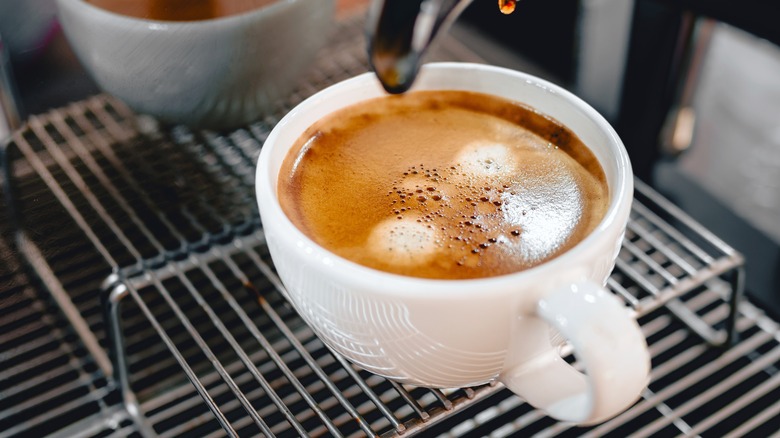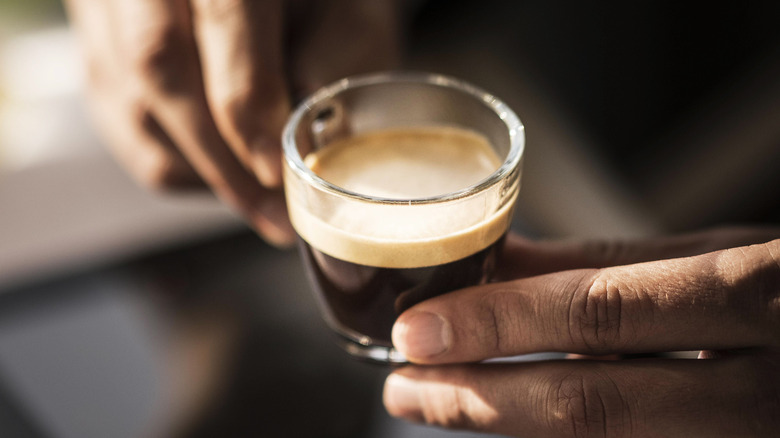The Difference Between Crema And Microfoam When It Comes To Coffee
Maybe you stepped into a fancy coffee bar and were quickly overwhelmed by the terminology thrown around, or perhaps you ordered a state-of-the-art, at-home espresso machine on impulse and suddenly realized your vocabulary is seriously lacking. In any case, coffee lingo can make your head spin — and if you are someone who does not know the difference between a partially-extracted ristretto and a doppio (a double shot of espresso), the terms crema and microfoam might not mean anything to you, either.
Both terms refer to a certain frothiness found in your coffee beverage, but crema is the layer that rises to the top of a shot of espresso, while microfoam is the warm and foamy milk that is poured on top of drinks like lattes. Despite the bubbly look of crema, it has more to do with flavor and aroma than texture, though the lighter brown, creamy layer does affect the mouthfeel to a small degree. On the other hand, microfoam primarily changes the texture of the milk by incorporating air, and warming it up via the foaming process also makes the dairy taste slightly sweeter.
How both crema and microfoam are made
Crema is produced when the carbon dioxide and oils in ground coffee beans combine together to create tiny bubbles, a byproduct of making espresso by forcing water through the grounds. However, there is no single strategy to make it just right. A shot of espresso with a notable layer of crema is affected by a variety of factors — the freshness of the beans, grind size, type of roast, speed and degree of extraction, style of machine, and so on. It takes a barista or a coffee hobbyist lots of practice to nail it every time. For many, the thick layer of crema is a marker of quality and skill, but others find that crema is not that important of an indicator.
Making microfoam is more specific, as there are particular techniques for steaming the milk that introduce the optimal amount of small bubbles. It's all about creating a cohesive, velvety texture, rather than the sort of light and airy foam you would find on a dry cappuccino.
Using a steam wand device, the milk is first aerated or "stretched." Then, using the wand in a side-to-side motion, the steam pressure and the angle the milk pitcher is held at create a vortex within the dairy, which is warmed until it reaches between 120 to 140 degrees Fahrenheit (a process called texturing). A loud steamer wand is a red flag which indicates that a barista's (or your own) technique is not quite right.
Why crema and microfoam matter
If you make your own espresso or order a shot and it winds up without much crema, that does not mean that it will automatically be unpleasant to drink. In fact, some baristas and coffee lovers advocate for scraping it off completely or stirring it into the espresso, because the foam can yield an overwhelmingly bitter and burnt taste. The pro-crema camp finds that the frothy layer makes the flavor and smell of the coffee bolder and prolongs the aftertaste, both of which increase the overall enjoyment of the cup. To see which team you land on, give both versions a try, or chat with the barista at your favorite coffee shop during a slow time of the day to get their professional opinion.
Meanwhile, well-made microfoam is the secret behind barista-approved, beautiful latte art. It has enough body to be poured into shapes and swirls, while also combining well with the espresso or coffee below. Even if you are less concerned with appearances, the texture of microfoam is what differentiates your latte from just coffee with milk stirred in. Those tiny bubbles disperse throughout the beverage, making for a super silky sip.



